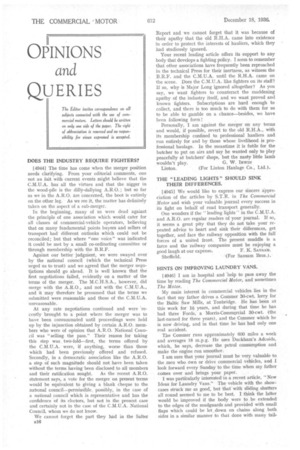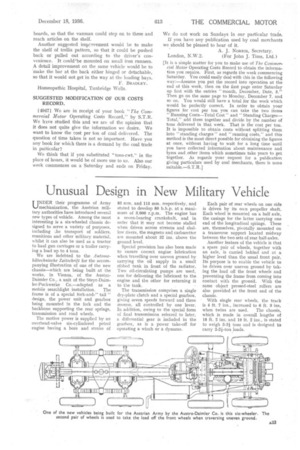OPINIONS and
Page 50

Page 51

If you've noticed an error in this article please click here to report it so we can fix it.
QUERIES
DOES THE INDUSTRY REQUIRE FIGHTERS?
[4944) The time has come when the merger position needs clarifying. From your editorial comments, one not au fait with current events might believe that the C.M.U.A. has all the virtues and that the nigger in the wood-pile is the dilly-dallying A.R.O.: but so far as we in the A.R.O. are concerned, the boot is entirely on the other leg. As we see it, the matter has definitely taken on the aspect of a sub-merger.
In the beginning, many of us were dead against the principle of one association which would cater for all classes of commercial-vehicle operators, believing that on many fundamental points buyers and sellers of transport had different outlooks which could not be reconciled; but that where "one voice" was indicated it could be met by a small co-ordinating committee or through membership with the B.R.F.
Against our better judgnient, we were swayed over by the national council (which the technical Press urged us to trust) and we agreed that the merger negotiations should go ahead. It is well known that the first negotiations failed, evidently on a matter of the terms of the merger. The M.C.H.S.A., however, did merge with the A.R.O., and not with the C.M.U.A., and it may therefore be presumed that the terms we .submitted were reasonable and those of the C.M.U.A. unreasonable. At any rate negotiations continued and were recently brought to a point where the merger was to have been consummated until proceedings were held up by the injunction obtained by certain A.R.O. members who were of opinion that A.R.O. National Council was "selling the pass." Their reason for taking this step was, two-fold—first, the terms offered by the C.M.U.A. were, if anything, worse than those which had been previously offered and refused. Secondly, in a democratic association like the A.R.O. a step of such magnitude should not have been taken without the terms having been disclosed to all members and their ratification sought. As the recent A.R.O. statement says, a vote for the merger on present terms would be equivalent to giving a blank cheque to the national council—permissible, possibly, in the case of a national .council which is representative and has the confidence of its electors, but not in the present case and certainly not in the case of the C.M.U.A. National Council, whom we do not know.
We cannot forget the part they had in the Salter n16 Report and we cannot forget that it was because of their apathy that the old R.H.A. carne into existence in order to protect the interests of hauliers, which they had studiously ignored.
Your recent leading article offers its support to any body that develops a fighting policy. I seem to remember that other associations have frequently been reproached in the technical Press for their inertness, as witness the B.R.F. and the C.M.U.A. until the R.H.A. came on the scene. Does the C.M.U.A. like fighters on its staff? If so, why is Major Long ignored altogether? As you say, we want fighters to counteract the maddening apathy of the industry itself, and we want proved and known fighters. Subscriptions are hard enough to collect, and there is too much to do with them for us to be able td gamble on a chance—besides, we have been following form !
Personally, I am against the merger on any terms and would, if possible, revert to the old R.H.A., with its membership confined to professional hauliers and run entirely for and by those whose livelihood is professional haulage. In the meantime it is futile for the butcher to put on airs and say he wanted only to play peacefully at butchers' Shops, but the nasty little lamb wouldn't play. G. W. Timm Linton. (For Linton Haulage Co., Ltd.).
THE "LEADING LIGHTS" SHOULD SINK THEIR DIFFERENCES.
[4945] We would like to express our sincere appreciation of the articles by S.T.R. in The Commercial Motor and wish your valuable journal every success in its fight on behalf of road transport generally.
One wonders if the "leading lights" in the C.M.U.A. and A.R.O. are regular readers of your journal. If so, it seems a great pity that they do not take your repeated advice to heart and sink their differences, get together, and face the railway opposition with the full forces of a united front. The present muddle is a farce and the 'railway companies must be enjoying a good laugh at our expense. F. K. SANSAM.
Sheffield. (For Samaria Bros.).
HINTS ON IMPROVING LAUNDRY VANS.
[49461 I am in hospital and help to pass away the time by reading The Commercial Motor, and sometimes The Motor.
My main interest in commercial vehicles lies in the fact that my father drives a Commer 30-cwt. lorry for the Baltic Saw Mills, at Tonbridge. He has been at this work for 16 years, and during that time he has had three Fords, a Morris-Commercial 30-cwt. (the last-named for three years), and the Commer which he is now driving, and in that time he has had only one real accident.
The Commer runs approximately 600 miles a week and averages 18 m.p.g. He uses Duckham's Adcoids, which, he says, decrease the petrol consumption and make the engine run smoother.
I am sure that your journal must be very valuable to the men who own or drive commercial vehicles, and I look forward every Sunday to the time when my father comes over and brings your paper.
I was particularly interested in a recent article, "New Ideas for Laundry Vans." The vehicle with the showcases struck me as good, but that with sliding shutters all round seemed to me to be best. I think the latter would be improved if the body were to be extended to the edges of the mudguards and provided with small flaps which could be let, down on chains along both sides in a similar manner to that done with many tail boards, so that the vanman could step on to these and reach articles on the Shelf.
Another suggested improvement would be to make the shelf of trellis pattern, so that it could be pushed back or pulled out according to the driver's convenience. It could'be mounted on small iron runners. A detail improvement on the same vehicle would be to 'make the bar at the back either hinged or detachable, so that it would not get in the way at the loading bays. F. BRADLEY. Homeopathic Hospital, Tunbridge Wells.
SUGGESTED MODIFICATION OF OUR COSTS' RECORD.
149471 We are in receipt of your book "Tie Commercial Motor Operating Costs Record," by S.T.R. We have studied this and we are of the opinion that it does not quite give the information we desire. We want to know the cost per ton of coal delivered. The question of time taken is not so important. Have you any book for which there is a demand by the coal trade in particular?
We think that if you substituted "tons-cwt," in the place of hours, it would be of more use to us. Also our week commences on a Saturday and ends on Friday. We do not work on Sundays in our particular trade. If you have any publication used by coal merchants we should be pleased to hear of it.
A. J. NORRIS, Secretary.
London, N.W.2.. (For John J. Tims, Ltd.) (It is a simple matter for you to make use of The Commercial Motor Operating Costs Record to obtain the information you require. First, as regards the week commencing Saturday. You could easily deal with this in the following way:—Assume you put the record into operation at the end of this week, then on the first page enter Saturday up first with the entries "month, December, Date, 5." Then go on the same page to Monday, December 7, and so on. You would still have a total for the week which would be perfectly correct. In order to obtain your figures for cost per ton you can take the two items " Running Costs—Total Cost" and "Standing Charges— Total," add them together and divide by the number of tons delivered in that week. That is the cost per ton. It is impossible to obtain costs without splitting them into "standing charges" and "running costs," and this method is the most direct possible for obtaining the figures at once, without having to wait for a long time until you have collected information about maintenance and tyres and .other items which sometimes take years to get together. As regards your request for a publication giving particulars used by coal merchants, there is none suitable.—S.T.R.]




















































































